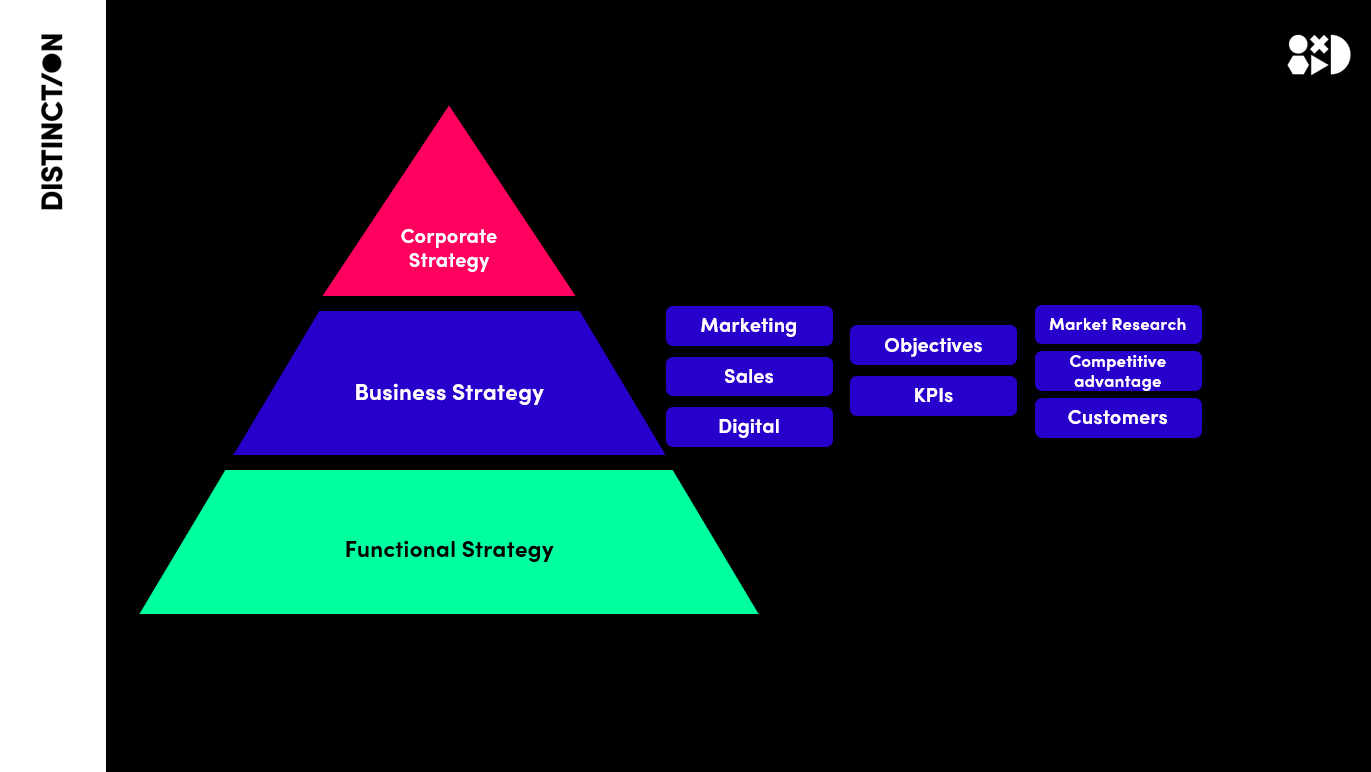

According to Harvard Business School 90 percent of organisations do not execute their strategies effectively.
There are many ways to make plans, but one method that's great at speaking to a whole team is a nested strategy approach.
In this article we define nested strategy, evaluate its effectiveness and weigh up whether it is right for your business.
At its core, nested strategy embodies the concept of a "strategy within strategy." Imagine a set of Russian nesting dolls, each fitting snugly within the other.
Similarly, nested strategy entails the development of multiple layers of planned strategy that align seamlessly from the topmost corporate level down to individual functional areas.
At the highest level, the corporate strategy sets the overarching direction and long-term objectives of the organisation.
This strategic vision cascades down through various business units and functional departments, with each layer of strategy contributing to the attainment of broader organisational goals.
Nested strategy includes several key components that work in harmony to drive organisational success.
At the top lies the corporate strategy, which defines the overall mission, vision, and objectives of the company.

This is complemented by business unit strategies, which outline how each division or segment will contribute to the realisation of corporate goals while considering its unique market dynamics and competitive landscape.

Further down the hierarchy, functional strategies come into play, outlining the specific actions and initiatives required within individual departments such as marketing, finance, operations, and human resources.
These functional strategies are intricately linked to both the overarching corporate strategy and the strategies of other business units, ensuring alignment and coherence across the organisation.

The adoption of nested strategy offers numerous benefits for organisations seeking to enhance their strategic agility and performance.
By establishing a clear hierarchy of strategic objectives and priorities, nested strategy allows better coordination and alignment across different levels of the organisation.
In large organisations, the approach can provide clear direction, with employees at every level potentially feeling invested in the strategy and direction of the business.
Furthermore, nested strategy promotes a more holistic approach to decision-making, enabling leaders to consider the broader implications of their actions on the organisation.
This integrated perspective fosters collaboration and synergy among different departments, driving innovation and efficiency throughout the organisation.
Nested strategy provides a framework for effective resource allocation, ensuring that investments and initiatives are aligned with strategic priorities and deliver maximum value.
By prioritising initiatives that support the overarching corporate strategy, organisations can optimise their resources and focus on activities that drive long-term growth and competitiveness.
If you work in a startup or scale-up, a nested strategy approach may feel more challenging as the team may not be large enough to own individual areas of strategy.
As employees often wear different hats in these fast-moving organisations, multiple people could own certain outcomes or KPIs.
As learning and solving problems is continuous a problem-focused strategy approach may work more effectively.
If your organisation struggles to empower its employees you may have difficulty implementing nested strategy .
Each level of the strategy should feed into each other and if strategy is only owned by board level the culture in the business may not facilitate the type of thinking needed for this approach to work.
There needs to be trust and openness in all levels of the business. Larger companies with lots of different departments can sometimes get too focused on planning instead of strategising.
Implementing nested strategy needs a structured approach encompassing strategic planning, effective communication, and seamless collaboration across all organisational tiers.
It begins with crafting a lucid and compelling corporate strategy that outlines the organisation's vision, mission, and strategic goals.
Subsequently, business unit leaders engage in cooperative efforts to formulate strategies harmonising with and bolstering the overarching corporate goals.
This entails finding market prospects, evaluating competitive challenges, and devising strategic initiatives aimed at fostering growth and profitability within their respective domains.
Concurrently, functional leaders translate the overarching strategic aims into actionable blueprints and endeavours within their departments.
They can do this themselves or seek help from a strategic partner who can help them diagnose and prioritise the solutions needed to hit their corporate goals.
By aligning their endeavours with both the corporate strategy and the strategies of business units, functional teams actively contribute to the long term success of the organisation.
Nested strategy implementation can greatly benefit from a roadmap which can clearly outline what needs to be done and who handles actioning it.
What you don’t want to happen is lots of conversations and no clear plan for each department.
Someone needs to own the roadmap in a nested strategy approach and the roadmap needs to be revisited often to ensure that the work is done.
We go into much more detail in how to create and manage a roadmap in our blog.
In an increasingly complex and uncertain business environment, nested strategy offers a powerful framework for aligning organisational goals, priorities, and actions across levels of a business.
By fostering coherence, collaboration, and agility, nested strategy can enable large organisations to navigate change, seize opportunities more efficiently.
Embracing nested strategy is not merely about developing strategic plans; it's about creating a culture of strategic thinking and execution that feeds into every aspect and owned by all the organisation.